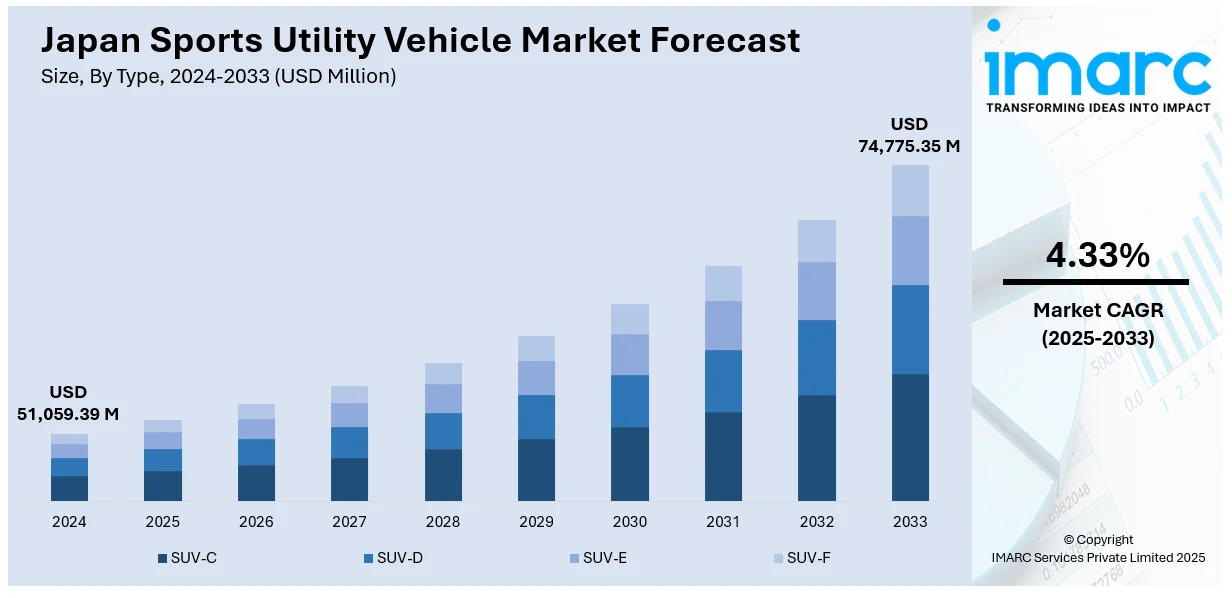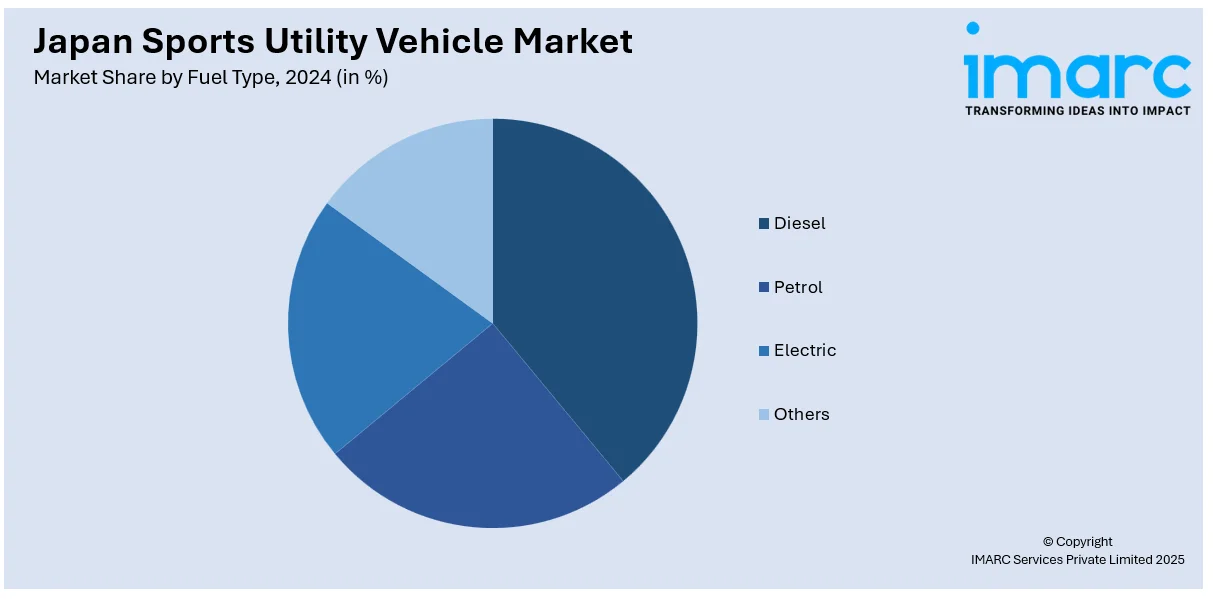
Japan Sports Utility Vehicle Market Size, Share, Trends and Forecast by Type, Fuel Type, Seating Capacity, and Region, 2025-2033
Japan Sports Utility Vehicle Market Overview:
The Japan sports utility vehicle market size reached USD 51,059.39 Million in 2024. Looking forward, IMARC Group expects the market to reach USD 74,775.35 Million by 2033, exhibiting a growth rate (CAGR) of 4.33% during 2025-2033. Growing demand for compact and mid-size sports utility vehicles, rising hybrid and electric vehicle (EV) adoption, and premiumization of vehicle features are shaping the market growth. Improved road infrastructure in rural, family preference for spacious interiors, and original equipment manufacturer (OEM) focus on Japan-specific sports utility vehicle models, are driving the market growth. Apart from this, surging leasing and subscription uptake, government incentives for green vehicles, sportier sports utility vehicle styling trends, and Kei-sized crossover popularity are factors boosting the Japan sports utility vehicle market share.
|
Report Attribute
|
Key Statistics
|
|---|---|
|
Base Year
|
2024 |
|
Forecast Years
|
2025-2033
|
|
Historical Years
|
2019-2024
|
| Market Size in 2024 | USD 51,059.39 Million |
| Market Forecast in 2033 | USD 74,775.35 Million |
| Market Growth Rate 2025-2033 | 4.33% |
Japan Sports Utility Vehicle Market Trends:
Rising Demand for Compact and Mid-Size Sports Utility Vehicles
The increasing need for compact and mid-size sports utility vehicles is highly impacting the Japan sports utility vehicle market. These vehicles offer a handy combination of affordable size, interior room, and fuel efficiency that makes them well suited for use in highly populated city centers as well as comparatively less populated regional areas. In highly populated cities like Tokyo and Osaka, where parking and road space are limited, larger cars are frequently impractical. Consequently, buyers are increasingly turning to versatile models that efficiently handle daily commuting, family use, and occasional long-distance driving. In line with this, companies have introduced models that are tailored for these uses, like the Toyota Yaris Cross and Honda Vezel, which are designed specifically for Japanese road conditions. For instance, in 2024, The Suzuki launched the Suzuki Fronx, which is a small SUV with a stylish coupe-like look. It’s built to be easy to drive and has a comfortable interior. The design is modern, and it’s made to be practical for everyday use.

Hybrid and Electric Sport Utility Vehicle Demand Growth
Hybrids and electric sports utility cars are leading the market as a consequence of environmental considerations and growing fuel prices influencing consumer demand. Japan experiences a strong national focus on energy efficiency and environmental protection that is aligned with rising popularity in low-emission cars. Hybrid sports utility cars are especially attractive as they provide improved gas mileage and lower emissions without any requirement for charging stations. Moreover, electric sports utility vehicles are also gradually picking up steam, aided by government subsidies, public education campaigns, and the expansion of electric vehicle charging points in city centers. These new products align with Japan's Green Growth Strategy and Japan's 2050 vision to achieve carbon neutrality, which is further supporting the Japan sports utility vehicle market growth.
Premiumization and Growth in Luxury Sports Utility Vehicle
The sports utility vehicle is witnessing a strong shift towards premium and luxury products led by higher disposable incomes and shifting consumer desires. Increasing numbers of customers are looking for luxury features, comfort, and style that reflect their lifestyle. This trend is creating strong demand for luxury sports utility vehicles that combine performance, good looks, and high-tech features. BMW, Mercedes-Benz, and Lexus are expanding their presence in this market, with the BMW X3 and Lexus RX being instances of models that are drawing high-end city consumers. These consumers desire features, such as panoramic glass roofs, leather seats, smart systems integrated, and driver assist technologies. The luxury segment is most vibrant in major cities, where high-end consumers that desire to project a status image are more likely to invest in premium cars.
Japan Sports Utility Vehicle Market Segmentation:
IMARC Group provides an analysis of the key trends in each segment of the market, along with forecasts at the country and regional levels for 2025-2033. Our report has categorized the market based on type, fuel type, and seating capacity.
Type Insights:
- SUV-C
- SUV-D
- SUV-E
- SUV-F
The report has provided a detailed breakup and analysis of the market based on the type. This includes SUV-C, SUV-D, SUV-E, and SUV-F.
Fuel Type Insights:

- Diesel
- Petrol
- Electric
- Others
A detailed breakup and analysis of the market based on the fuel type have also been provided in the report. This includes diesel, petrol, electric, and others.
Seating Capacity Insights:
- 5-Seater
- 7-Seater
- 8-Seater and Above
The report has provided a detailed breakup and analysis of the market based on the seating capacity. This includes 5-seater, 7-seater, and 8-seater and above.
Regional Insights:
- Kanto Region
- Kansai/Kinki Region
- Central/Chubu Region
- Kyushu-Okinawa Region
- Tohoku Region
- Chugoku Region
- Hokkaido Region
- Shikoku Region
The report has also provided a comprehensive analysis of all the major regional markets, which include Kanto Region, Kansai/Kinki Region, Central/Chubu Region, Kyushu-Okinawa Region, Tohoku Region, Chugoku Region, Hokkaido Region, and Shikoku Region.
Competitive Landscape:
The market research report has also provided a comprehensive analysis of the competitive landscape. Competitive analysis such as market structure, key player positioning, top winning strategies, competitive dashboard, and company evaluation quadrant has been covered in the report. Also, detailed profiles of all major companies have been provided.
Japan Sports Utility Vehicle Market News:
- In 2025, Suzuki unveiled the E Vitara, its first electric SUV, developed in partnership with Toyota. The vehicle offers two battery options (49kWh and 61kWh) and will be produced in India, targeting markets including Japan, Europe, and India by mid-2025.
- In 2024, Honda and Nissan announced plans to merge, aiming to form the world's third-largest car manufacturer. The merger seeks to enhance competitiveness in the global market, particularly in electric vehicle development.
Japan Sports Utility Vehicle Market Report Coverage:
| Report Features | Details |
|---|---|
| Base Year of the Analysis | 2024 |
| Historical Period | 2019-2024 |
| Forecast Period | 2025-2033 |
| Units | Million USD |
| Scope of the Report |
Exploration of Historical Trends and Market Outlook, Industry Catalysts and Challenges, Segment-Wise Historical and Future Market Assessment:
|
| Types Covered | SUV-C, SUV-D, SUV-E, SUV-F |
| Fuel Types Covered | Diesel, Petrol, Electric, Others |
| Seating Capacities Covered | 5-Seater, 7-Seater, 8-Seater and Above |
| Regions Covered | Kanto Region, Kansai/Kinki Region, Central/Chubu Region, Kyushu-Okinawa Region, Tohoku Region, Chugoku Region, Hokkaido Region, Shikoku Region |
| Customization Scope | 10% Free Customization |
| Post-Sale Analyst Support | 10-12 Weeks |
| Delivery Format | PDF and Excel through Email (We can also provide the editable version of the report in PPT/Word format on special request) |
Key Questions Answered in This Report:
- How has the Japan sports utility vehicle market performed so far and how will it perform in the coming years?
- What is the breakup of the Japan sports utility vehicle market on the basis of type?
- What is the breakup of the Japan sports utility vehicle market on the basis of fuel type?
- What is the breakup of the Japan sports utility vehicle market on the basis of seating capacity?
- What is the breakup of the Japan sports utility vehicle market on the basis of region?
- What are the various stages in the value chain of the Japan sports utility vehicle market?
- What are the key driving factors and challenges in the Japan sports utility vehicle market?
- What is the structure of the Japan sports utility vehicle market and who are the key players?
- What is the degree of competition in the Japan sports utility vehicle market?
Key Benefits for Stakeholders:
- IMARC’s industry report offers a comprehensive quantitative analysis of various market segments, historical and current market trends, market forecasts, and dynamics of the Japan sports utility vehicle market from 2019-2033.
- The research report provides the latest information on the market drivers, challenges, and opportunities in the Japan sports utility vehicle market.
- Porter's five forces analysis assist stakeholders in assessing the impact of new entrants, competitive rivalry, supplier power, buyer power, and the threat of substitution. It helps stakeholders to analyze the level of competition within the Japan sports utility vehicle industry and its attractiveness.
- Competitive landscape allows stakeholders to understand their competitive environment and provides an insight into the current positions of key players in the market.
Need more help?
- Speak to our experienced analysts for insights on the current market scenarios.
- Include additional segments and countries to customize the report as per your requirement.
- Gain an unparalleled competitive advantage in your domain by understanding how to utilize the report and positively impacting your operations and revenue.
- For further assistance, please connect with our analysts.
 Request Customization
Request Customization
 Speak to an Analyst
Speak to an Analyst
 Request Brochure
Request Brochure
 Inquire Before Buying
Inquire Before Buying




.webp)




.webp)












